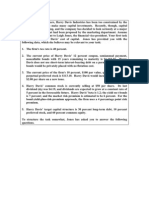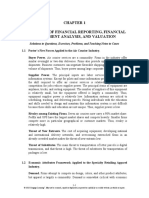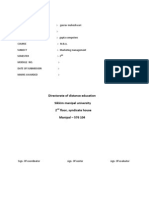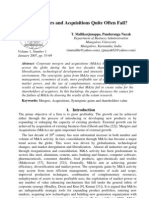80%(5)80% found this document useful (5 votes)
7K viewsBKM CH 11 Answers W CFA
BKM CH 11 Answers W CFA
Uploaded by
levajunkThe document discusses various aspects of the efficient market hypothesis (EMH). Some key points:
1) If markets are efficient, stock returns between non-overlapping periods should be uncorrelated.
2) Successful companies like Microsoft earning large profits does not violate EMH if investors earned correct risk-adjusted returns.
3) Expected returns vary based on risk, not being equal across all securities as the EMH allows for multiple risk factors to impact returns.
Copyright:
© All Rights Reserved
Available Formats
Download as DOCX, PDF, TXT or read online from Scribd
BKM CH 11 Answers W CFA
BKM CH 11 Answers W CFA
Uploaded by
levajunk80%(5)80% found this document useful (5 votes)
7K views10 pagesThe document discusses various aspects of the efficient market hypothesis (EMH). Some key points:
1) If markets are efficient, stock returns between non-overlapping periods should be uncorrelated.
2) Successful companies like Microsoft earning large profits does not violate EMH if investors earned correct risk-adjusted returns.
3) Expected returns vary based on risk, not being equal across all securities as the EMH allows for multiple risk factors to impact returns.
Original Description:
BKM Ch 11 Answers
Original Title
BKM Ch 11 Answers w CFA
Copyright
© © All Rights Reserved
Available Formats
DOCX, PDF, TXT or read online from Scribd
Share this document
Did you find this document useful?
Is this content inappropriate?
The document discusses various aspects of the efficient market hypothesis (EMH). Some key points:
1) If markets are efficient, stock returns between non-overlapping periods should be uncorrelated.
2) Successful companies like Microsoft earning large profits does not violate EMH if investors earned correct risk-adjusted returns.
3) Expected returns vary based on risk, not being equal across all securities as the EMH allows for multiple risk factors to impact returns.
Copyright:
© All Rights Reserved
Available Formats
Download as DOCX, PDF, TXT or read online from Scribd
Download as docx, pdf, or txt
80%(5)80% found this document useful (5 votes)
7K views10 pagesBKM CH 11 Answers W CFA
BKM CH 11 Answers W CFA
Uploaded by
levajunkThe document discusses various aspects of the efficient market hypothesis (EMH). Some key points:
1) If markets are efficient, stock returns between non-overlapping periods should be uncorrelated.
2) Successful companies like Microsoft earning large profits does not violate EMH if investors earned correct risk-adjusted returns.
3) Expected returns vary based on risk, not being equal across all securities as the EMH allows for multiple risk factors to impact returns.
Copyright:
© All Rights Reserved
Available Formats
Download as DOCX, PDF, TXT or read online from Scribd
Download as docx, pdf, or txt
You are on page 1of 10
At a glance
Powered by AI
The key takeaways are that the EMH asserts that stock prices reflect all available information and that it is difficult to 'beat the market' through technical or fundamental analysis alone.
The different forms of the EMH are weak, semi-strong, and strong. Weak form implies past prices reflect all information, semi-strong implies public information is reflected, and strong form implies all private information is also reflected.
According to the EMH, expected returns are determined by risk factors like beta and other risk premiums. Riskier securities command higher expected returns.
1
Chapter 11: The Efficient Market Hypothesis
1. If markets are efficient, what should be the correlation coefficient between stock returns for
two non-overlapping time periods?
If markets are efficient, then the correlation coefficient between stock returns for two non-
overlapping periods (the autocorrelation) should be zero. If not, one could use returns from one
period to predict returns in later periods and make abnormal profits.
Note that we do observer some non-zero return autocorrelations. See page 358 to 359 in the text.
2. A successful firm like Microsoft has consistently generated large profits for years. Is this a
violation of the EMH?
No. The EMH implies that Microsofts investors, over any period, have earned the correct risk-
adjusted return on their investment.
3. If all securities are fairly priced, all must offer equal expected rates of return. Comment.
No. Expected rates of return vary according to premium earned from incurring risk. The CAPM
implies that the risk-premium of a security is solely a function of its share of market risk (as
measured by its market-beta), while other theories/models allow for other priced risk-factors.
For example, according the results of tests of the Fama-French Three Factor Model (FF3F Model), a
securitys risk-premium (its return in excess of the risk-free return) is a function of its market risk
(measured by market beta), its relative size (measured by SMB beta) and its relative price (its book
value of equity to its market value of equity measured by HML beta).
Other risk factors such as exchange rates or commodity prices may also be important to determining
the correct risk premia.
4. Steady Growth Industries has never missed a dividend payment in its 94-year history.
Does this make it more attractive to you as a possible purchase for your stock portfolio?
Not more (or less) attractive. The EMH implies the predictability of its dividend is reflected in
the stocks price. A predictable dividend would likely lower the perceived risk and therefore
decrease the required return and therefore increase the price.
5. At a cocktail party, your co-worker tells you that he has beaten the market for each of the
last 3 years. Suppose you believe him. Does this shake your belief in efficient markets?
Assume beat the market means a return in excess of the return on the S&P 500. It may be
that case that the coworker bought high risk stocks (CAPM > 1) and held them in an up
market. In this case the coworker might have earned a return commensurate with the risk
incurred. To determine if the coworker earned a risk-adjusted excess return calculate the .
2
If you use just the market return, then it is called the CAPM (also called Jensons ):
R
P
= + R
M
+
If you use the market return, the small stock premium (SMB) and value stock premium (HML),
then it is called the Fama-French :
R
P
= +
M
R
M
+
SMB
SMB +
HML
HML +
Recall that SMB in each time period equals the return to a portfolio of small stocks less the
return to a portfolio of big stocks and is therefore the small stock premium.
HML in each time period equals the return to a portfolio of high BM (value stocks) less the
return to a portfolio of Low BM (growth stocks) and is therefore the value stock premium.
If the portfolio, be requirement, held only oil service stocks, and therefore incurred oil risk
R
P
= +
M
R
M
+
SMB
SMB +
HML
HML +
Oil
R
Oil
+
In any case, a positive and significant indicates excess return after accounting for risk. If is
not positive and significant, and the portfolios return is in excess of the market return then it
may be due to some type of increased risk () and not skill ().
6. Highly variable stock prices suggest that the market does not know how to price stocks.
Comment.
The EMH states price changes are caused by new information which market participants use to
update expectations and then rebalance portfolios. Volatile prices caused by volatile
underlying economic conditions and volatile changes in expectations is consistent with the
EMH.
7. Why are the following effects considered efficient market anomalies? Are there rational
explanations for any of these effects?
(a) P/E effect.
(b) Book-to-market effect.
(c) Momentum effect.
(d) Small-firm effect.
A trading rule that can be used to earn risk-adjusted abnormal returns is sometimes called an
Efficient Market Anomaly.
The P/E effect and Book-to-Market effect are names for the observed higher returns earned by value
stocks. The Small-firm effect is a name for the observed higher returns earned by small stocks.
Are these violations of the EMH or are these example of returns earned for realized risk? Over time
and across stocks, value stocks and small stocks have positive and significant CAPM s. Growth
3
stocks and large stocks have negative and significant CAPM s. This might suggest a strategy for
risk-adjusted excess returns over time.
However, it is possible that the CAPM (a single factor index model) does not fully account for all
risk factors which affect a returns. A firm that is riskier may have a lower price and therefore a
lower P/E multiple. If this is true, the holders of value stocks are just being compensated for
incurring the extra risk. The same analysis can be applied to small stocks.
Some studies show stock price exhibiting positive and significant autocorrelation with past
performance over short to intermediate horizons and negatively and significant autocorrelation over
long horizons.
Possible explanations are that investors underreact in the short term to new information which causes
positive returns to be followed by positive returns and negative returns to be followed by negative
returns. In the long term this would cause some stocks to have an incorrectly high relative price (and
therefore be a growth stock) and others to have an incorrectly low price (and therefore be a value
stock). The subsequent corrections to these incorrect prices would cause the value stock to earn
more that the growth stock and be consistent with long-term negative autocorrelation.
The short term return persistence (positive autocorrelation) could also be caused by a bandwagon
effect or herding behavior.
8. If prices are as likely to increase as decrease, why do investors earn positive returns from the
market on average?
Over the long term, there is an expected upward drift in stock prices based on their risk-adjusted
expected rates of return. The expected return over any single day is very small. For example 10% per
year is only 10%/365 = 0.0274% per day, so that on any day the price is virtually equally likely to
rise or fall since the long-term upward drift component is so small relative to other factors that cause
daily returns.
However, over longer periods, the small expected daily returns accumulate, and upward moves are
indeed more likely than downward ones. We can see this in the annual arithmetic mean returns for
different classes of securities covered in Chapter 5 and the discussion of technology implementation
and productivity increases in your notes.
9. Which of the following most appears to contradict the proposition that the stock market is
weakly efficient? Explain.
(a) Over 25% of mutual funds outperform the market on average.
(b) Insiders earn abnormal trading profits.
(c) Every January, the stock market (at least small stocks) earns abnormal returns.
Twenty-fve percent of mutual funds outperforming the market and insiders earning abnormal returns
on private information would not violate the weak form. Therefore only (c), a predictable and easily
followed rule to earn abnormal returns would violate the weak form.
4
Note that the stock market does not rise predictable every January. It did for a while then it was
thought that only small firms rose in January then the whole January Effect stopped. See page
361 in the text or this USA Today article which indicates that the January Effect has migrated to
December.
Another possible reason for the discovery of this January Effect anomaly is data mining. If market
participants look hard enough for anomalies (price or return patterns), they will find them.
Computer power and data are cheap. It is easy to look for patterns. It does not mean there is any
recurring effect.
11. Suppose that, after conducting an analysis of past stock prices, you come up with the following
observations. Which would appear to contradict the weak form of the efficient market
hypothesis? Explain.
(a) The average rate of return is significantly greater than zero.
(b) The correlation between the return during a given week and the return during the
following week is zero.
(c) One could have made superior returns by buying stock after a 10% rise in price and selling
after a 10% fall.
(d) One could have made higher-than-average capital gains by holding stocks with low
dividend yields.
Not (a). Compensation for incurring risk is consistent with the EMH.
Not (b). Zero autocorrelation is consistent with the EMH.
Not (d). The statement is observed higher than average capital gains (not returns) on stocks with
low dividend yields. Stocks that dont pay dividends reinvest profits (retain earnings) and the
stocks price increases.
Statement (c) is describing positive autocorrelation (also called serial correlation and is an example
of a classic simple filter rule which should not be able to produce superior returns if markets are
weak-form efficient. (Note that this is not an observed result.)
12. Which of the following statements are true if the efficient market hypothesis holds?
(a) It implies that future events can be forecast with perfect accuracy.
(b) It implies that prices reflect all available information.
(c) It implies that security prices change for no discernible reason.
(d) It implies that prices do not fluctuate.
Only (b) is true. This is the definition of an efficient market.
13. Respond to each of the following comments.
(a) If stock prices follow a random walk, then capital markets are little different from a casino.
Stock prices tend to follow a random walk in the short run. Long term returns tend to be
positive and compensate the hold for the risks incurred form holding the security.
5
(b) A good part of a company's future prospects are predictable. Given this fact, stock prices
can't possibly follow a random walk.
Some part of a companys future prospects may be predictable. Some parts may not be
predictable. One way to think about it is that market participants prize predictability so
securities with claims on the prospects of more predictable companies will have higher prices
and lower returns.
(c) If markets are efficient, you might as well select your portfolio by throwing darts at the
stock listings in The Wall Street Journal.
The EMH predicts market participants will earn a return commensurate with risk. This implies
that security selection is still important in order fit a portfolio to the investors desired risk level.
14. Which of the following would be a viable way to earn abnormally high trading profits if
markets are semistrong-form efficient?
(a) Buy shares in companies with low P/E ratios.
(b) Buy shares in companies with recent above-average price changes.
(c) Buy shares in companies with recent below-average price changes.
(d) Buy shares in companies for which you have advance knowledge of an improvement in the
management team.
If prices reflect all available information (semi-stong form efficient) then abnormally high
trading profits (risk-adjusted excess returns) are only available from advanced (inside?)
information.
16. If the business cycle is predictable, and a stock has a positive beta, the stock's returns also
must be predictable. Respond.
The statement, as written, is true. The problem is that business cycles are not predictable.
20. In a recent closely contested lawsuit, Apex sued Bpex for patent infringement. The jury came
back today with its decision. The rate of return on Apex was r
A
= 3.1%. The rate of return on
Bpex was only r
B
= 2.5%. The market today responded to very encouraging news about the
unemployment rate, and r
M
= 3%. The historical relationship between returns on these stocks
and the market portfolio has been estimated from index model regressions as:
Apex: r
A
= 0.2% + 1.4r
M
Bpex: r
B
= -0.1% + 0.6r
M
On the basis of these data, which company do you think won the lawsuit?
Given market performance, predicted returns on the two stocks would be:
Apex: 0.2% + (1.4 x 3%) = 4.4%
Bpex: -0.1% + (0.6 x 3%) = 1.7%
Apex underperformed and Bpex outperformed so Bpex won the lawsuit.
6
22. Dollar-cost averaging means that you buy equal dollar amounts of a stock every period, for
example, $500 per month. The strategy is based on the idea that when the stock price is low,
your fixed monthly purchase will buy more shares, and when the price is high, fewer shares.
Averaging over time, you will end up buying more shares when the stock is cheaper and fewer
when it is relatively expensive. Therefore, by design, you will exhibit good market timing.
Evaluate this strategy.
The term Dollar-Cost Averaging can refer to two strategies.
The first way dollar-cost averaging works is this:
Today buy $10,000 of GE at $40 per share (buy 250 shares).
Later if the price decreases (or maybe because the price has decreased and now my $40 shares are
losers) buy another $10,000 of GE at $20 per share (buy another 500 shares).
Total shares = 750
Total cost = $20,000
Average cost per share = $20,000/750 = $26.67
The idea is to turn around my bad decision to buy GE at $40 since the aggregate GE position
will be profitable at a price above $26.67. Implicit in the decision to pay $20 is that the price must
go up again, since what goes down must go up.
This may not be the correct way to think about it. The purchase of the $40 shares and the purchase
of the $20 shares are separate investment decision and should be evaluated separately. If you like
GE at $20, buy it. That fact that you already own some at $40 is irrelevant.
The second way Dollar-Cost Averaging works is as described in the text: I want buy $20k of
GE so buy $5,000 every month four months. Ill end up buying more shares when the price is
low and fewer shares when the price is high. Implicit in this strategy is the notion that stock
prices fluctuate around a normal level. Otherwise, there is no meaning to statements such as
when the price is high. How do we know, for example, whether a price of $25 today will turn
out to be viewed as high or low compared to the stock price six months from now?
23. We know that the market should respond positively to good news and that good-news events
such as the coming end of a recession can be predicted with at least some accuracy. Why, then,
can we not predict that the market will go up as the economy recovers?
The market responds positively to new information. If an eventual recovery is anticipated, then
(according to the EMH) the recovery is already reflected in stock prices. Only a better-than-
expected recovery should affect stock prices.
26. Good News, Inc., just announced an increase in its annual earnings, yet its stock price fell. Is
there a rational explanation for this phenomenon?
The market may have anticipated an even greater increase in annual earnings. Compared to the
expectations, the announcement was a disappointment.
7
Additional Question:
What are the three forms of the Efficient Market Hypothesis (EMH) and what should we expect to
observe if a form holds (is true) or does not hold?
Strong Form of the EMH: Prices reflect ALL information.
If it holds:
You can earn risk-adjusted returns abnormal returns (beat the market) only if you are lucky. So
we should not observe people beating in greater number than would be expected if it were random
You cannot earn risk-adjusted returns abnormal returns even with inside information.
Prices will not react to announcements.
Semi-Strong Form of the EMH: Prices reflect ALL AVAILABLE or PUBLIC information.
If it holds:
Prices will react to announcements.
You can beat the market using inside (and therefore illegal) information
Lucky people will beat the market but not in numbers exceeding what we expect to see if it were
random.
You cannot earn risk-adjusted abnormal returns even if you work hard and spend money to try to
find mispriced securities.
Weak Form of the EMH: Prices reflect only EASILY AVAILABLE or CHEAP information.
If it holds:
Prices will react to announcements.
You can beat the market using inside (and therefore illegal) information
Lucky people will beat the market but not in numbers exceeding what we expect to see if it were
random.
You can beat the market using difficult to obtain information (spending lots of time or money to
acquire the information) or superior analysis.
There is good evidence that the strong form is not true (or does not hold) since we see prices move
when information which was previously known only to insiders is announced. We also observe that
insiders can earn risk-adjusted abnormal returns (beat the market) when they act on inside (and illegal)
information.
The EMH only says - within the bounds of increasingly strong assumptions about the information
processing of investors - that assets are fairly priced. An implication of this is that - on average - the
typical market participant cannot earn excessive profits from a particular trading strategy.
However, that does not mean that some individual investors wont outperform the market over some
investment horizon. Certain investors who do well for a period of time get a lot of attention from the
financial press, but the scores of investors who do not do well over the same period of time generally get
considerably less attention.
8
The question is: Are results of investors like Warren Buffet evidence that markets are not efficient?
This is difficult to answer. It may be the case that he is just lucky and markets are efficient. It may be
the case that he just works really really hard and is really really smart. So maybe his results are
evidence that markets are weak-form efficient, meaning that you cannot earn superior risk-adjusted
returns (beat the market) looking only at cheap easily-available information, but that markets are not
semi-strong efficient, meaning you can beat the market using public information only if you work hard
and are smart.
CFA PROBLEMS
1. b. Semi-strong form efficiency implies that market prices reflect all publicly available
information concerning past trading history as well as fundamental aspects of the firm.
2. a. The full price adjustment should occur just as the news about the dividend becomes publicly
available.
3. d. If low P/E stocks tend to have positive abnormal returns, this would represent an unexploited
profit opportunity that would provide evidence that investors are not using all available
information to make profitable investments.
4. c. In an efficient market, no securities are consistently overpriced or underpriced. While some
securities will turn out after any investment period to have provided positive alphas (i.e.,
risk-adjusted abnormal returns) and some negative alphas, these past returns are not
predictive of future returns.
5. c. A random walk implies that stock price changes are unpredictable, using past price changes
or any other data.
6. d. A gradual adjustment to fundamental values would allow for the use of strategies based on past
price movements in order to generate abnormal profits.
7. a.
8. a. Some empirical evidence that supports the EMH:
(i) professional money managers do not typically earn higher returns than comparable risk,
passive index strategies;
(ii) event studies typically show that stocks respond immediately to the public release of
relevant news;
(iii) most tests of technical analysis find that it is difficult to identify price trends that can be
exploited to earn superior risk-adjusted investment returns.
b. Some evidence that is difficult to reconcile with the EMH concerns simple portfolio strategies
that apparently would have provided high risk-adjusted returns in the past. Some examples of
portfolios with attractive historical returns:
(i) low P/E stocks;
(ii) high book-to-market ratio stocks;
(iii) small firms in January;
9
(iv) firms with very poor stock price performance in the last few months.
Other evidence concerns post-earnings-announcement stock price drift and intermediate-term
price momentum.
c. An investor might choose not to index even if markets are efficient because he or she may
want to tailor a portfolio to specific tax considerations or to specific risk management issues,
for example, the need to hedge (or at least not add to) exposure to a particular source of risk
(e.g., industry exposure).
9. a. The efficient market hypothesis (EMH) states that a market is efficient if security prices
immediately and fully reflect all available relevant information. If the market fully reflects
information, the knowledge of that information would not allow an investor to profit from the
information because stock prices already incorporate the information.
i. The weak form of the EMH asserts that stock prices reflect all the information that can be
derived by examining market trading data such as the history of past prices and trading volume.
A strong body of evidence supports weak-form efficiency in the major U.S. securities markets.
For example, test results suggest that technical trading rules do not produce superior returns
after adjusting for transaction costs and taxes.
ii. The semistrong form states that a firms stock price reflects all publicly available
information about a firms prospects. Examples of publicly available information are company
annual reports and investment advisory data.
Evidence strongly supports the notion of semistrong efficiency, but occasional studies (e.g.,
those identifying market anomalies such as the small-firm-in-January or book-to-market
effects) and events (such as the stock market crash of October 19, 1987) are inconsistent with
this form of market efficiency. However, there is a question concerning the extent to which
these anomalies result from data mining.
iii. The strong form of the EMH holds that current market prices reflect all information
(whether publicly available or privately held) that can be relevant to the valuation of the firm.
Empirical evidence suggests that strong-form efficiency does not hold. If this form were
correct, prices would fully reflect all information. Therefore even insiders could not earn
excess returns. But the evidence is that corporate officers do have access to pertinent
information long enough before public release to enable them to profit from trading on this
information.
b. i. Technical analysis involves the search for recurrent and predictable patterns in stock prices in
order to enhance returns. The EMH implies that technical analysis is without value. If past prices
contain no useful information for predicting future prices, there is no point in following any
technical trading rule.
ii. Fundamental analysis uses earnings and dividend prospects of the firm, expectations of future
interest rates, and risk evaluation of the firm to determine proper stock prices. The EMH predicts
that most fundamental analysis is doomed to failure. According to semistrong-form efficiency, no
investor can earn excess returns from trading rules based on publicly available information. Only
analysts with unique insight achieve superior returns.
10
In summary, the EMH holds that the market appears to adjust so quickly to information about
both individual stocks and the economy as a whole that no technique of selecting a portfolio using
either technical or fundamental analysis can consistently outperform a strategy of simply buying
and holding a diversified portfolio of securities, such as those comprising the popular market
indexes.
c. Portfolio managers have several roles and responsibilities even in perfectly efficient markets. The
most important responsibility is to identify the risk/return objectives for a portfolio given the
investors constraints. In an efficient market, portfolio managers are responsible for tailoring the
portfolio to meet the investors needs, rather than to beat the market, which requires identifying
the clients return requirements and risk tolerance. Rational portfolio management also requires
examining the investors constraints, including liquidity, time horizon, laws and regulations,
taxes, and unique preferences and circumstances such as age and employment.
10. a. The earnings (and dividend) growth rate of growth stocks may be consistently overestimated by
investors. Investors may extrapolate recent growth too far into the future and thereby downplay
the inevitable slowdown. At any given time, growth stocks are likely to revert to (lower) mean
returns and value stocks are likely to revert to (higher) mean returns, often over an extended
future time horizon.
b. In efficient markets, the current prices of stocks already reflect all known relevant information. In
this situation, growth stocks and value stocks provide the same risk-adjusted expected return.
You might also like
- The Auditor The Instructional Novella v2Document12 pagesThe Auditor The Instructional Novella v2tomNo ratings yet
- INVEST Joel Greenblatt ClassguideDocument20 pagesINVEST Joel Greenblatt ClassguideClick LivrosNo ratings yet
- Chapter 5Document5 pagesChapter 5JavNo ratings yet
- Analysis of Audited Financial Statements of San Miguel Corporation 2021Document28 pagesAnalysis of Audited Financial Statements of San Miguel Corporation 2021Marquez, Jazzmine K.No ratings yet
- Corporate Debt Restructuring in Emerging Markets: A Practical Post-Pandemic GuideFrom EverandCorporate Debt Restructuring in Emerging Markets: A Practical Post-Pandemic GuideNo ratings yet
- Finance Interview QuestionsDocument3 pagesFinance Interview Questionsk gowtham kumarNo ratings yet
- Stock Pitch SampleDocument8 pagesStock Pitch SampleMuyuchen ShiNo ratings yet
- Harry DavisDocument6 pagesHarry Davispocidogu100% (1)
- Uv6790 PDF EngDocument20 pagesUv6790 PDF EngRicardo BuitragoNo ratings yet
- Overview of Financial Reporting, Financial Statement Analysis, and ValuationDocument32 pagesOverview of Financial Reporting, Financial Statement Analysis, and ValuationVũ Việt Vân AnhNo ratings yet
- 10 BrazosDocument20 pages10 BrazosAlexander Jason LumantaoNo ratings yet
- Creating Value From Mergers and Acquisitions - ToCDocument7 pagesCreating Value From Mergers and Acquisitions - ToCredaek0% (1)
- Mergers & AcquisitionsDocument2 pagesMergers & AcquisitionsRashleen AroraNo ratings yet
- Fin 367 Sample Problems Chapters 10-11, 13-16Document21 pagesFin 367 Sample Problems Chapters 10-11, 13-16Nicholas Jack KhooNo ratings yet
- Chapter 17 Solutions BKM Investments 9eDocument11 pagesChapter 17 Solutions BKM Investments 9enpiper29100% (1)
- Financial Ratios2Document72 pagesFinancial Ratios2Junel Alapa100% (1)
- Introduction To Monetary PolicyDocument32 pagesIntroduction To Monetary PolicycaamitbhartiNo ratings yet
- Corporate Finance - Berk DeMarzo- Test Bank Chapter 19 - 百度文库Document26 pagesCorporate Finance - Berk DeMarzo- Test Bank Chapter 19 - 百度文库TaanzNo ratings yet
- Financial Statement Analysis & Security Valuation (Fifth Edition)Document46 pagesFinancial Statement Analysis & Security Valuation (Fifth Edition)arunjangra566No ratings yet
- Problem Set #1 Solution: Part 1 (Cost of Capital)Document4 pagesProblem Set #1 Solution: Part 1 (Cost of Capital)Shirley YeungNo ratings yet
- Mock Interview 11jan16Document1 pageMock Interview 11jan16Chen ZhenxiongNo ratings yet
- Capital Investment Appraisal in Retail Business Management: Sainsbury's As A Case StudyDocument6 pagesCapital Investment Appraisal in Retail Business Management: Sainsbury's As A Case StudyIOSRjournalNo ratings yet
- If I Would Like To Protect My Downside, How Would I Structure The Investment?Document6 pagesIf I Would Like To Protect My Downside, How Would I Structure The Investment?helloNo ratings yet
- Case Study 5Document3 pagesCase Study 5Farhanie NordinNo ratings yet
- Simulation CaseDocument7 pagesSimulation Casekeith105No ratings yet
- Accounting Clinic IVDocument36 pagesAccounting Clinic IVPrabowoNo ratings yet
- CH 06 - Risk, Return, and The Capital Asset Pricing ModelDocument60 pagesCH 06 - Risk, Return, and The Capital Asset Pricing ModelSyed Mohib HassanNo ratings yet
- Buffett CaseDocument15 pagesBuffett CaseElizabeth MillerNo ratings yet
- Malibu Boats Inc (DCF + Valuation)Document5 pagesMalibu Boats Inc (DCF + Valuation)Linh Linh NguyễnNo ratings yet
- Capital Structure: Capital Structure Refers To The Amount of Debt And/or Equity Employed by ADocument12 pagesCapital Structure: Capital Structure Refers To The Amount of Debt And/or Equity Employed by AKath LeynesNo ratings yet
- FSAV3eModules 5-8Document26 pagesFSAV3eModules 5-8bobdoleNo ratings yet
- Chapter 15 Solutions: Solutions To Questions For Review and DiscussionDocument28 pagesChapter 15 Solutions: Solutions To Questions For Review and DiscussionAlbert CruzNo ratings yet
- Investment Banking Cover Letter TemplateDocument1 pageInvestment Banking Cover Letter Templateasdfa0% (1)
- Numericals On Stock Swap - SolutionDocument15 pagesNumericals On Stock Swap - SolutionAnimesh Singh GautamNo ratings yet
- The Impact of Financial Leverage To Profitability Study of Vehicle Companies From PakistanDocument21 pagesThe Impact of Financial Leverage To Profitability Study of Vehicle Companies From PakistanAhmad Ali100% (1)
- Problem Set 6Document6 pagesProblem Set 6Aneudy Mota CatalinoNo ratings yet
- Chapter 16Document23 pagesChapter 16JJNo ratings yet
- SXL RecommendationDocument13 pagesSXL RecommendationKalaniNo ratings yet
- Chapter 2 AnswerDocument11 pagesChapter 2 AnswerLogeswary VijayakumarNo ratings yet
- BKM CH 08 Answers W CFADocument9 pagesBKM CH 08 Answers W CFAzyNo ratings yet
- Capital StructureDocument11 pagesCapital StructureSathya Bharathi100% (1)
- Case 8 - Rosetta Stone Pricing The 2009 IPO-1Document1 pageCase 8 - Rosetta Stone Pricing The 2009 IPO-1EmmaLeeNo ratings yet
- WhiteMonk HEG Equity Research ReportDocument15 pagesWhiteMonk HEG Equity Research ReportgirishamrNo ratings yet
- Return On EquityDocument7 pagesReturn On EquityTumwine Kahweza ProsperNo ratings yet
- Corporate Finance Practice ExamDocument11 pagesCorporate Finance Practice ExamPeng Jin100% (1)
- Case Study Cost of CapitalDocument60 pagesCase Study Cost of CapitalcranpiseNo ratings yet
- Tutorial 6: Chap 7 Efficient Diversification: The Following Data Apply To Problem 4 Through 10: A Pension Fund Manager IsDocument4 pagesTutorial 6: Chap 7 Efficient Diversification: The Following Data Apply To Problem 4 Through 10: A Pension Fund Manager IsLim Xiaopei100% (1)
- Bootstrapping Spot RateDocument37 pagesBootstrapping Spot Ratevirgoss850% (2)
- Key Technical Questions For Finance InterviewsDocument27 pagesKey Technical Questions For Finance InterviewsSeb SNo ratings yet
- Pioneer Petroleum AnalysisDocument10 pagesPioneer Petroleum AnalysisAdan Fernando Valencia FuentesNo ratings yet
- Answers To The Case Study - Financial Report AnalysisDocument4 pagesAnswers To The Case Study - Financial Report AnalysisJohn Shiju100% (2)
- Investment Banking Cover Letter TemplateDocument2 pagesInvestment Banking Cover Letter TemplateBrian OuNo ratings yet
- Capital Structure Theory Current PerspectiveDocument13 pagesCapital Structure Theory Current PerspectiveAli GardeziNo ratings yet
- Valuation MetricsDocument18 pagesValuation MetricsVALUEWALK LLCNo ratings yet
- EV The Price of A BusinessDocument11 pagesEV The Price of A BusinessseadwellerNo ratings yet
- Calculate Customer Lifetime Value A Clear and Concise ReferenceFrom EverandCalculate Customer Lifetime Value A Clear and Concise ReferenceNo ratings yet
- Cost Of Capital A Complete Guide - 2020 EditionFrom EverandCost Of Capital A Complete Guide - 2020 EditionRating: 4 out of 5 stars4/5 (1)
- Chapter 1 Accounting EquationDocument25 pagesChapter 1 Accounting EquationRameshNo ratings yet
- Marketing PrimerDocument71 pagesMarketing PrimerTathagat AryaNo ratings yet
- Week 02Document22 pagesWeek 02olivia hoNo ratings yet
- Marketing ASSIGNMENTDocument23 pagesMarketing ASSIGNMENTThant ThandarNo ratings yet
- Returnable Goods Register: STR/4/005 Issue 1 Page1Of1Document1 pageReturnable Goods Register: STR/4/005 Issue 1 Page1Of1Zohaib QasimNo ratings yet
- Ls Retail Nav EnglishDocument20 pagesLs Retail Nav EnglishAnilNo ratings yet
- MCQ CH1Document7 pagesMCQ CH1Mahmoud ElmahdyNo ratings yet
- Quiz MidtermDocument4 pagesQuiz MidtermKyla DizonNo ratings yet
- Directorate of Distance Education: Sikkim Manipal University 2 Floor, Syndicate House Manipal - 576 104Document24 pagesDirectorate of Distance Education: Sikkim Manipal University 2 Floor, Syndicate House Manipal - 576 104Sachin JainNo ratings yet
- EDI Adoption in Saudi Arabia-Ncc16Document24 pagesEDI Adoption in Saudi Arabia-Ncc16dheerajtiwari1No ratings yet
- Assignments On TMDocument2 pagesAssignments On TMShriya JainNo ratings yet
- Barbeque Nation Hospitality LTDDocument39 pagesBarbeque Nation Hospitality LTDRahul SharmaNo ratings yet
- Numerical On Final AccountDocument7 pagesNumerical On Final AccountVikas giri100% (1)
- Avoiding Fraudulent TransfersDocument8 pagesAvoiding Fraudulent TransfersNamamm fnfmfdnNo ratings yet
- UNIT 6 InventoriesDocument22 pagesUNIT 6 InventoriesRey ViloriaNo ratings yet
- New Ways To Depreciate Fixed Assets in ERP 6 1Document4 pagesNew Ways To Depreciate Fixed Assets in ERP 6 1Neelesh KumarNo ratings yet
- Why M&As Fail Often?Document17 pagesWhy M&As Fail Often?Insideout100% (4)
- Global Data Market Size 2017 2021 OnAudience ReportDocument26 pagesGlobal Data Market Size 2017 2021 OnAudience ReportAndré VasconcelosNo ratings yet
- TOOLS, DIES and Industrial MoldsDocument282 pagesTOOLS, DIES and Industrial MoldsDaniel FigueiredoNo ratings yet
- Lect 13 & 14 EntrepreneurshipDocument29 pagesLect 13 & 14 EntrepreneurshipHaseeb Ur RehmanNo ratings yet
- Kanoo Shipping: Your Local Shipping Partner in The Middle EastDocument13 pagesKanoo Shipping: Your Local Shipping Partner in The Middle EastTom CatNo ratings yet
- Common Mistakes in Letter WritingDocument6 pagesCommon Mistakes in Letter WritingJericaMababaNo ratings yet
- Dry Goods Warehouse: Management Trainee Household Department (Plasticware Section)Document26 pagesDry Goods Warehouse: Management Trainee Household Department (Plasticware Section)Ronald San Juan LamataNo ratings yet
- Deloitte ES TMT European Health Fitness Market 2019Document12 pagesDeloitte ES TMT European Health Fitness Market 2019Varo HidalgoNo ratings yet
- Doctrine of lifting of corporate veilDocument20 pagesDoctrine of lifting of corporate veilAnkit JainNo ratings yet
- Cloud Kitchen Strategic AnalysisDocument8 pagesCloud Kitchen Strategic AnalysisRatnesh Kumar RaiNo ratings yet
- Audit of The Sales and Collection CycleDocument43 pagesAudit of The Sales and Collection CyclesusilawatiNo ratings yet
- Public Financial Management Assessment in The PhilippinesDocument13 pagesPublic Financial Management Assessment in The PhilippinesOliva MervzNo ratings yet

























































































